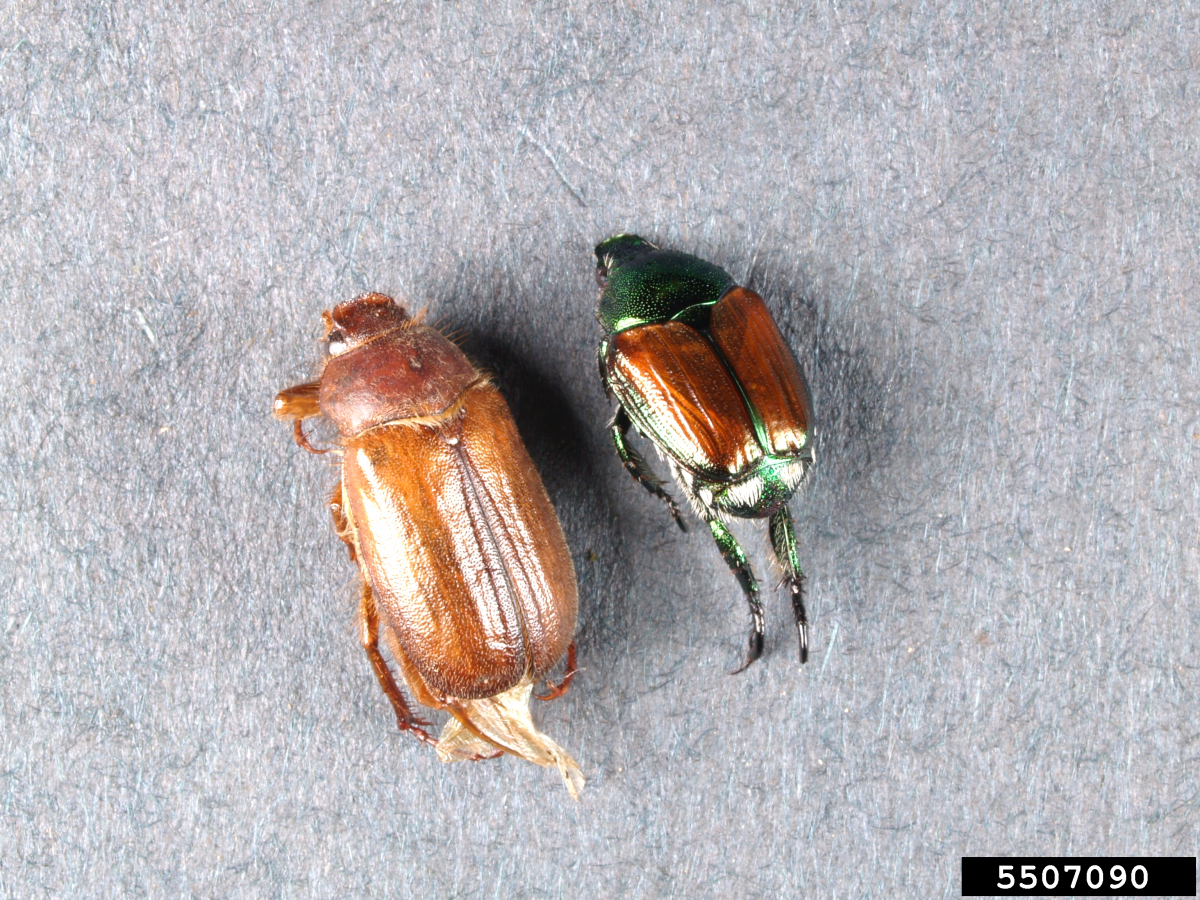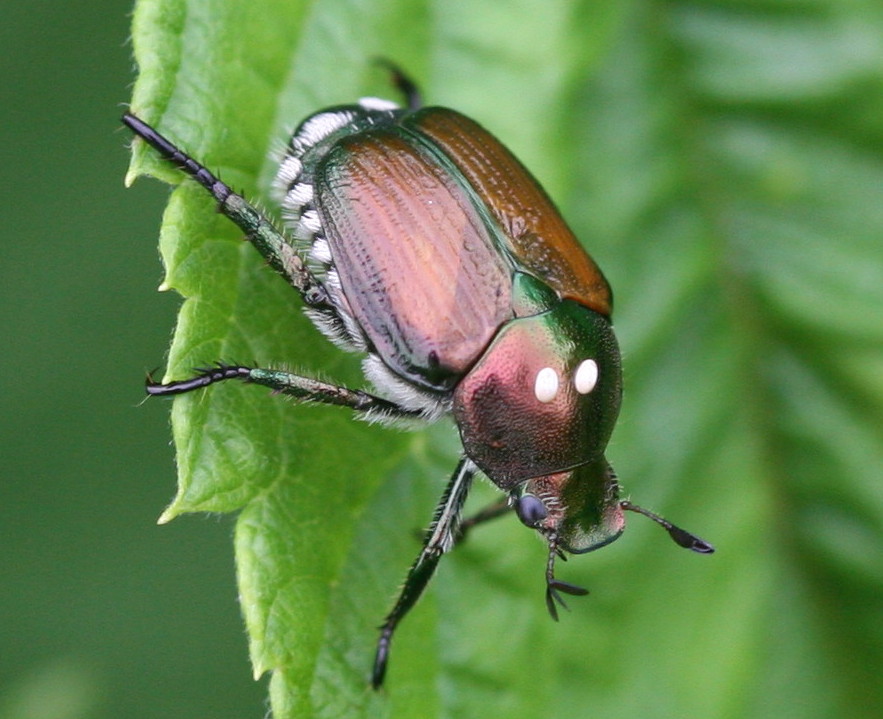Introduction
There are several insects and mites that feed on grass, but not all cause economic or aesthetic damage. Many of them are harmless and beneficial and thus, should be encouraged. Those that do cause significant damage and may need immediate control include the white grubs, hairy chinch bug, and sod webworm.
Before dashing off to a garden center for an insecticide, make sure an insect is indeed the culprit of your problem. There are a number of other causes for brown and dying grass such as drought, disease, and improper application of fertilizers or pesticides. If the damage is caused by insects, it is important to identify which of the three major home lawn insect pests is involved so you can select the right control method. Use pesticides as a last resort and only in accordance with label directions.
White Grubs
White grubs are the larval stage of several species of beetles and chafers belonging to the family Scarabaeidae. The most troublesome white grubs in New Hampshire are the Japanese beetle and the European chafer. (Another, the Asiatic garden beetle looks like
a small European chafer, flies to light at night and can become a nuisance. The adult feeds on a wide variety of foliage and flowers and the larvae feed on grass roots. It is not considered a serious lawn pest because it is so small that it requires a very large number to injure lawns.) White grub larvae are so similar in appearance, telling the species apart usually requires good magnification and an illustrated key.
Japanese beetle and European chafer larvae are C-shaped and feed on grass roots. They are typically cream-colored with a brown head and a dark area at their posterior end, where the body contents show through the skin. Japanese beetles and European chafers complete their development in one year.
White grubs are the larval stage of several species of beetles and chafers belonging to the family Scarabaeidae. The most troublesome white grubs in New Hampshire are the Japanese beetle and the European chafer.
Japanese beetles lay their eggs in July and August and the European chafers in late June. The eggs hatch and the young grubs begin feeding on grass roots within one or two weeks. They feed until fall when they burrow deep into the ground to overwinter. In spring, the grubs burrow upwards to the grass roots and resume feeding until late May when they transform into pupae. Peak emergence for Japanese beetles occurs about the first week of July and European chafers about two weeks earlier.
Patches of dead grass are evidence of a white grub infestation. Usually the dead, dry grass pulls out by the handful or rolls back like a rug to reveal grubs feeding on roots. Bird, mole, or skunk damage in the lawn can also signal a large population of grubs. Be forewarned: treating for grubs rarely controls mole populations. Moles are carnivores that eat earthworms and many other soil insects.
To determine if grubs are causing the damage, dig a spadeful of the dead area of your lawn. Examine for grubs. Grass can usually maintain a grub population of 10 grubs per square foot of ground before the grubs do significant damage. If you have 10 or more grubs, you may want to consider management.
It is important to note that in order to manage the grub population you will also need to manage the adult population (especially that of the Japanese beetle and the Asiatic garden beetle).


White Grub Management - IPM Strategies:
- Cultural Practices and Non-Chemical Controls: (1) Physical removal and exclusion. Handpicking and using nets to cover plants during peak beetle activity. (2) Withholding of irrigation during peak beetle flight activity may reduce grub populations because soil moisture is essential for egg survival and larval development.
- Biological Control: (1) A tachinid fly (Istocheta aldrichi) found in lawns and around shrubbery, attaches eggs to the thorax of newly emerged adult Japanese beetles. The egg hatches and the maggot develops within the host. (2) Ants and ground beetles feed on eggs and young larvae of these beetles.(3) Skunks eagerly dig out and eat grubs from lawns, and although this may reduce grub numbers, it creates a visual disturbance in the lawn that takes a while to heal.
- Chemical Control: No matter which type of grub you have in your lawn, the best time to apply a chemical control is summer while the grubs are still small and actively feeding. The fat, mature grubs of early spring and late summer are more difficult to control. There are a number of pesticides registered in New Hampshire for controlling white grubs. For specific chemical recommendations, contact your local Extension office or the toll free information line (if you are a homeowner) at 1-877-398-4769.
Hairy Chinch Bug
The most destructive pest of home lawns, the hairy chinch bug, damages grass by piercing blades with its needle-like mouthpart and sucking plant juices. The adult is 1/16" long and black, with white wings and reddish legs. The small nymph is wingless and appears red.
Chinch bugs prefer to feed on bluegrass and fescues. They also prefer sunny areas and lawns with thatch. Rainy weather hinders chinch bugs development, so damage is less likely during wet periods. The overwintering adults emerge from sheltered areas in early spring and seek grass plants. Females lay eggs when temperatures reach 70°F, generally in May. The eggs hatch into young nymphs, which cause the greatest damage.
Damage to turf is first observed in late June. This begins as yellowish areas that soon become dead patches. During warm weather the damage spreads quickly as the bug population multiplies. New adults appear in July, producing a second generation in August.
Hairy Chinch Bug Management - IPM Strategies:
- Cultural Practices: (1) Proper lawn care is key. Keep a well-fertilized and nutrient rich soil, but do not over fertilize. Testing your soil prior to fertilizing is recommended. Grass should be mowed no shorter that 3". (2) Using endophyte-enhanced turfgrass seeds as part of your management program can help reduce the damage caused by hairy chinch bugs. Endophyte-enhanced seeds can negatively impact the health of livestock, so it is imperative that you follow all label directions regarding where you use these seeds.
- Monitoring: Chinch bug damage appears quickly in hot weather and is often confused with drought damage. If you suspect chinch bugs, try one of those two monitoring methods: (1) Get down on your hands and knees and search the crown of the grass next to the damaged area. Chinch bugs are most active and visible during the heat of the day.(2) Find an area of the lawn where living grass meets dead grass. Push one end of an open-ended coffee can into this area and fill the can with water for approximately 10 minutes. Watch for chinch bugs floating in the can. If 10 or more are found, you have a problem.
- Biological Practices: The big-eyed bug is the primary predator of hairy chinch bug nymphs and adults.
- Chemical Control: Sites which normally have chinch bug problems can be treated preventively in May and early June, killing overwintering adults and young nymphs before they cause significant damage. However, you should sample the area to determine chinch bug density prior to applying any control measure. For specific chemical recommendations, contact your local Extension office or the toll free information line (if you are a homeowner) at 1-877-398-4769.

Sod Webworm
The sod webworm is the caterpillar stage of a small 1" long, tan moth, often seen flying about the lawn in jerky, short flights. The caterpillars are 3/4" long when full grown, brown, or gray and spotted. They construct silk lined tunnels in the soil and come out to feed on grass at night. Damage first appears as small, irregular brown patches. Flocks of birds seen on the turf are one indication of the presence of sod webworm. Birds make probing holes into the turf as they search for the caterpillars, often causing much damage to lawns in the process.
When the weather warms in spring, the overwintering caterpillars resume feeding on the grass. Damage is first observed in late June or July. Adults moths appear in July, mate, and lay eggs. The larvae of these moths cause damage in August.
,%20adult,%20Cappaert,%20bugwood2146001-LGPT.jpg)

Sod Webworm Management - IPM Strategies:
- Monitoring - To sample for sod webworms, look carefully at the damaged area for silken tunnels. Alternatively, mix one tablespoon of liquid dish-washing detergent or 1/4 cup of powdered detergent with a gallon of water. Apply this liquid to one square yard (9 square feet) of turf. The soap irritates webworms and forces them to the surface. Most caterpillars respond to the soapy solution within two to five minutes. This technique is particularly helpful for determining what stages (sizes) of caterpillars are present.
- Biological Control - Bacillus thuringiensis var. kurstaki, a bacterium which produces a toxin and paralyzes the gut of the caterpillar, is available commercially for use on turf. An entomopathopenic nematode, Steinernema carpocapsae, is also available. Field trials indicate that this nematode, available commercially in a variety of formulations, can reduce caterpillar populations significantly. The nematode is very vulnerable to desiccation, so it is important to keep it away from excessive heat and dry conditions.
- Chemical Control - For best results, apply insecticides in late afternoon or early evening when larvae are active. For specific chemical recommendations, contact your local Extension office or the toll free information line (if you are a homeowner) at 1-877-398-4769.
New Hampshire Shoreland Protection Act
The New Hampshire Shoreland Protection Act prohibits the application of any fertilizers within 250 feet of surface waters, with the exception of limestone, slow-release nitrogen, and low-phosphorus products. State law also prohibits use of all pesticides and all fertilizers except limestone within 25 feet of shore.
Although state law does not regulate the use of pesticides and fertilizers on lawns and landscapes that drain into shallow (dug) wells on private property, UNH Cooperative Extension urges home gardeners to err on the side of safety in protecting their drinking water supply. Even environmentally-friendly products may pose health risks to humans and domestic animals if the product drains into drinking water. As a rule of thumb, we suggest applying no pesticides and limiting fertilizers to agricultural lime and slow-release nitrogen within 75 feet of a shallow well.
Stop! Read the label on every pesticide container each time before using the material. Pesticides must be applied only as directed on the label to be in compliance with the law. All pesticides listed in this publication are contingent upon continued registration. Contact the Division of Pesticide Control at (603) 271-3550 to check registration status. Dispose of empty containers safely, according to New Hampshire regulations.
Download the Resource for the complete fact sheet and a printable version.

